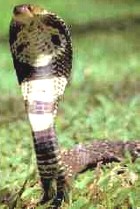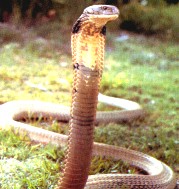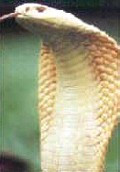 Cobra is the common name for members of the family of venomous snakes, Elapidae, known for their intimidating looks and deadly bite. These reptiles are found throughout the Philippines, southern Asia, and Africa. Cobras are recognized by the hoods behind their heads. A cobra opens this hood when it is angry or disturbed; the hood is created by the extension of the ribs behind the cobra's head. Cobra is the common name for members of the family of venomous snakes, Elapidae, known for their intimidating looks and deadly bite. These reptiles are found throughout the Philippines, southern Asia, and Africa. Cobras are recognized by the hoods behind their heads. A cobra opens this hood when it is angry or disturbed; the hood is created by the extension of the ribs behind the cobra's head.Cobras will seldom attack unprovoked. When threatened, however, the cobra will make full use of its menacing appearance and deadly venom. Cobras are famous for their use by Oriental snake charmers because they are intelligent, respond well to visual cues, and are of spectacular appearance. Cobras are common in Asia and Africa, and there are different types in each location. ASIAN COBRAS: King Cobras are the only snakes that build nests. The nest has two stories, and consists of mounds of leaves (preferably bamboo) that the queen whips together with her body coils. The female King Cobra lays up to 40 eggs on the first floor, then rests on the second story while watching her eggs. The baby King Cobra is about a foot and a half long when born! The Asian Cobra is other cobra of Asia, also known simply as the common or Indian cobra. It seldom reaches a length of more than 6 ft. However, its hood is, proportionally, much larger than that of the King cobra. This snake causes thousands of deaths each year in India, where it is regarded with religious awe, and is seldom killed.  AFRICAN COBRAS: AFRICAN COBRAS:Most cobras are natives of Africa. The black-necked cobra, or 'spitting cobra', is found from Egypt to northern South Africa. This snake can spray its venom accurately, and will often attempt to spit its venom in the eyes of an animal it feels threatened by, causing pain and temporary blindness. The ringhals, a different type of spitting cobra, is native to southern Africa, and is the smallest of the cobras, reaching only about 4 feet in length. The asp, or Egyptian cobra, is found throughout Africa, and is the most common. VENOM:  A venom's effects depend on its chemical nature, the stinging or biting mechanism used, the amount of venom delivered, and the size and condition of the victim. For example, all spiders are venomous, but the venoms of most are too weak, or delivered in too tiny quantities, to have much of an effect on humans. Also, many spiders can't puncture human skin. As a result, few of them are poisonous to humans, ... but their venoms are quite effective on insect prey. A venom's effects depend on its chemical nature, the stinging or biting mechanism used, the amount of venom delivered, and the size and condition of the victim. For example, all spiders are venomous, but the venoms of most are too weak, or delivered in too tiny quantities, to have much of an effect on humans. Also, many spiders can't puncture human skin. As a result, few of them are poisonous to humans, ... but their venoms are quite effective on insect prey.Snake venom is usually delivered in larger quantities, and more effectively. It can be hemotoxic (damaging blood vessels and causing hemorrhage) or neurotoxic (paralyzing nerve centers that control respiration and heart action); it can also contain chemicals that promote or prevent blood clotting. The venom of cobras, a neurotoxin, acts on the nervous system. With effective serum more available, however, the high death rate from cobra bites in some areas of Asia has decreased. It has been said that baby snakes are deadlier than adults. While there seems to be no evidence for this, a possible explanation might be that, while an adult cobra can control the the amount of venom delivered with each bite, depending on the threat it feels, a baby snake has no control over the amount of venom it can deliver, always giving a full dose. A baby cobra is fully able to defend itself in as little as three hours after being born. Cobras are immune to the venom produced by their own species. Venoms have occasional medicinal uses; for example, some are used as painkillers in cases of arthritis or cancer, and some serve as coagulants for people with hemophilia. Cobra venom has been used for many years in medical research because it contains an enzyme that dissolves the cell walls and membranes surrounding viruses. WHAT COBRAS EAT: Cobras often feed on eggs and chicks raided from poultry houses. Their natural prey includes small mammals, toads, lizards, birds and other snakes. The King Cobra will seek out and feed on any variety of snake that crosses its path. It will even eat other venomous and poisonous snakes if it's really hungry. It has even been known to eat other cobras! PREDATORS: Information was obtained from various encyclopedias and sources on the Web. A special thank-you to John A. Klein at the Cobra Information Site |
